There seems to be some kind of stigma with the term “step-child”, for some reason. I should know. I had a step-father and was, therefore, a step-child. I can’t say that I was always treated the same as my half-sisters, but that’s another story. How many times have you heard the phrase “I’ll beat you like a red-headed step child” in your life? I know I’ve heard it thousands of times over the years and probably used it myself for some reason. There are some firearms that are considered a step-child for some reason, and I don’t quite understand why.
Just because a particular firearm doesn’t fall into a certain category, or it isn’t as popular as one of its siblings, is no reason to reject it or treat it any differently than any other member of the family. I’m sure I’m guilty of this myself. Some firearms just don’t ring my bells, or it isn’t a very hot seller for a gun company. However, that doesn’t automatically mean that a particular firearm isn’t as useful as its siblings, not in my book!
The Glock 30 is something of a step-child in the Glock line-up, and I don’t understand why. Yeah, the Glock 30 is a little bit chunkier than some of its siblings, but do we reject our siblings, spouses, children, or any family member simply because they are a little chunkier than us? I think not! The Glock 30 is 1.28 inches thick, depending on who you believe, whereas the very popular Glock 19 is 1.18 inches thick. That’s not really all that much difference between the two, when it comes down to it. However, the Glock 19 is a 9mm, and the Glock 30 is a .45 ACP.
Where we find some differences is when we grip the two guns side-by-side. The Glock 19 is much thinner in the grip, front to back, making it feel a little thinner than the Glock 30. To many people, the difference is too much for their hands. I have large but not overly large hands, and both the 19 and 30 feel good in my hand. The 19 holds 15 rounds of 9mm, whereas the 30 only holds 10 rounds. When you place the two guns side-by-side, there really isn’t much visual difference. The difference lies in the way they feel. I’m a huge fan of the 1911 in .45 ACP and can shoot them extremely well and fast. The Glock 30, with the slightly wider and thicker grip area, really absorbs the recoil, even with the hottest loads. So, I can shoot it extremely fast and accurately, too.
The reason I’m comparing the Glock 19 and 30 to one another is because they really are similar in size. They just “feel” a little different in the hand. The overall dimensions are very close to one another in most respects though. The barrel length on the 30 is 3.78 inches. The 19 has a slightly longer barrel, ever so slightly. So, when it comes to concealing either gun, there isn’t that much difference, at least not to me. As an experiment, I had my wife slide the guns on my belt,using a Glock combat holster without my looking to see which gun she was putting on my belt. I honestly couldn’t tell the difference between the two guns on my belt. The 19 weighs 23.65 ounces empty, and the 30 weighs 26.98 ounces empty.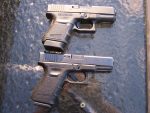
Now, there is a slight difference in the dimensions between the Glock 30 and the newer Glock 30S, and you can feel it in the hand if you have the guns side-by-side and repeatedly hold one and then the other. However, the difference isn’t that great, if you ask me. Iit just depends on how it feels to you. My wife is very big on how a gun feels in her hand. If it doesn’t feel just right, she isn’t interested in it. A gun that feels really good in her hand will be one that she shoots much better than one that doesn’t feel as good to her.
Of course, the Glock line-up of handguns all have polymer frames and a steel slide. The trigger pull is about the same, around 5.5 lbs for a standard model and slightly lighter on some target models. It is fairly easy to make the trigger pull lighter on a Glock, too. Everyone believes that Glock came out with the first polymer framed handgun, and that’s not true. It was H&K. Most Glocks have polymer sights, front and rear, with the front being a white dot and the rear has a white outline. They are fast to pick-up, not the best for target work, but more than good enough for combat work!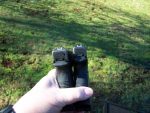
Anytime my local FFL dealer gets in a used Glock 30, they try to sell it fast by marking the price down, hoping someone will snap it up. Many people just don’t like the “chunky” feel to the gun. I’m not one of them, not when you hold it next to some of the other Glocks. The difference just isn’t all that much. And, as I stated, the 30 feels good in my hand. Also, being a little thicker side-to-side and front-to-back in the grip, the gun absorbs the recoil of the .45 ACP very well, thank you. Even the hottest P+ loads aren’t a problem for the Glock 30.
My Glock 30 was purchased used, and it had ejection problems. Someone played around with the ejector. I’m assuming that they wanted their empty brass to fall into one direction or one area and they bent the dickens out of the ejector. I was able to get it back to spec, but I ordered a new replacement. It took all of five minutes to replace it. The gun had been around the block with some scratches on the slide. It was probably dropped more than once. However, the gun was only $375. I know a deal when I see one, so a few scratches here and there weren’t of any concern.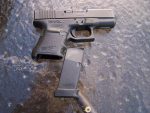
I’m not going to get into a debate over which caliber is “better”– the 9mm, .40 S&W, or .45ACP– and those are the main calibers most of us use for self defense. With today’s advances in JHP and bullet designs, all three calibers are good stoppers if the rounds are placed where they are supposed to go. I can often be caught carrying my Glock 26, because I like the compact size, and with the Glock +2 floor plates on the magazine that gives 12+1 rounds of 9mm on hand with a spare mag on my belt. Now, if pushed, in my own mind I know that the .45ACP is a better stopper. It just puts the bad guys down faster than the other two calibers do. How much faster? I’m not sure anyone has done a study on it. I just know in my mind that the .45 ACP puts the bad guys down faster, end of debate!
If I were tasked with going into a building that had armed terrorists in it and I could only carry a handgun, my first choice would be a 1911 in .45ACP. That’s how confident I am of the .45 ACP round to get the job done!
The Glock 30 has a magazine floor plate on it that is already “extended”, but I preferred the ones from Pearce Grip, which is a has a bit more of a “lip” on it for really holding my pinky finger on to it a little better. I also carry my Glock 30 in a Glock combat holster made of polymer, of course. It’s just hard to beat these skinny and super-thin holsters for concealed carry. To be sure, the combat holster for the Glock 30 is slightly larger than that of the other Glock combat holsters. The 30 won’t fit in the smaller holsters. It’s close, but there’s no cigar! How can you beat a holster that holds the gun tight and close to your body, will last for years, and only costs $12.95? 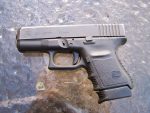
After replacing the ejector on my Glock 30, I had no ejection problems of any kind. I only had a few with the defective ejector. I had an outstanding assortment of .45 ACP on-hand, for testing, too. From Black Hills Ammunition, I had their 230-gr FMJ, 185-gr JHP, 230-gr JHP, 230- JHP +P, and their 185-gr Barnes TAC XP all-copper hollow point +P load. From Buffalo Bore Ammunition, I had their 255-gr Hard Cast Outdoorsman +P load, 230-gr FMJ FN +P, 185-gr JHP +P, 160-gr Barnes TAC XP all-copper hollow point +P, 185-gr Barnes TAC XP all-copper hollow point +P, 200-gr JHP +P, and their 160-gr Barnes TAC XP all-copper hollow point low recoil load.
Accuracy testing was done at 25 yards, resting the Glock 30 over a shooting bag on top of a rock. The short 3.78-inch barrel really performed. No groups were over four inches, and most groups were 3½ inches, and two groups were in a dead heat for best of day, at three inches, so long as I did my part. All shooting was done over a couple weeks, so some days I was on my game and other days my groups weren’t where they should have been. Tied for first place is the Black Hills 230-gr FMJ and the Buffalo Bore 230-gr FMJ FN +P loads. The Glock didn’t mind the hotter +P loads in the least, and the low recoil, standard velocity 160-gr Barnes TAC XP load from Buffalo Bore functioned 100%. I was a little worried about this one since the recoil spring on the Glock is a bit stout, but this load functioned perfectly. It’s a good load if you are a little recoil sensitive. 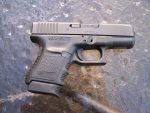
I looked around on the ‘net, and it looks like the Glock 30 is selling for around $500 new, and a little bit more for the 30S. If I were buying a brand new Glock 30, I guess I would opt for the 30S with the slightly thinner feel to it, front to back, in the grip area. However, there is nothing wrong at all with the 30. It may be a step-child in the Glock family, but it will hold its own against any of its siblings, if you ask me. If you want a compact .45 ACP handgun, though “compact” means different things to different people, then check out the Glock 30.
– Senior Product Review Editor, Pat Cascio









